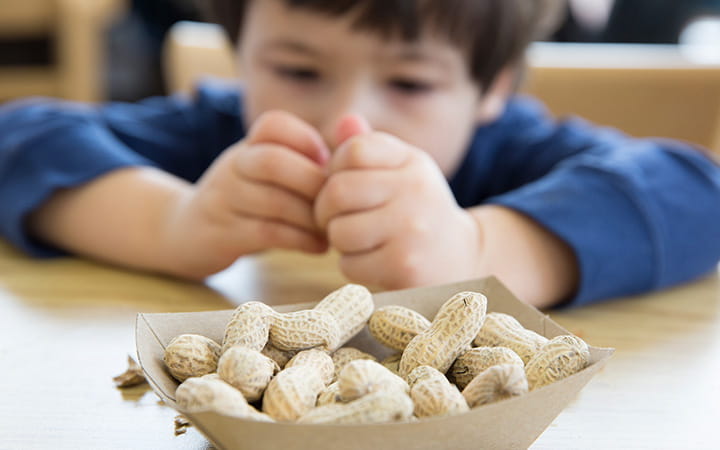A Drug-Free Therapy for Children with Peanut Allergies
July 06, 2020
 University Hospitals Rainbow Babies & Children'sExperts in Children's Health
University Hospitals Rainbow Babies & Children'sExperts in Children's Health

If your pediatrician or allergist has diagnosed your child with a peanut allergy, you may think you are destined to spend the rest of their childhood scanning labels, avoiding birthday parties for fear of exposure, and keeping an Epi-pen within reach at all times. The threat is real – peanuts are one of the food allergens most commonly associated with anaphylaxis – a dangerous, whole-body allergic reaction that can be life-threatening and requires immediate medical attention. Milder symptoms may include vomiting, stomach cramps, diarrhea, hives and shortness of breath.
“The occurrence of peanut allergies, the most common food allergy in children, has tripled over the past two decades,” says Eli Silver, MD, pediatric allergy and immunology specialist at UH Rainbow Babies & Children's. “Although there are various theories about why peanut allergies are now so prevalent, there is no definitive answer at this time. But the good news is, there is a treatment available to help desensitize children to peanuts and other food allergens – it’s called oral immunotherapy or OIT.”
How Does OIT Work?
Allergic reactions to food occur when the body’s immune system identifies the food as “foreign” and manufactures antibodies to fight it. Whenever the food is eaten, the antibodies forcefully attack, producing the symptoms of a food allergy. It is not known why the immune system reacts this way in some children but it has been proven that food allergies do run in families. “For example, the siblings of a peanut-allergic child are seven times more likely to have the same allergy when compared to kids in the general population,” Dr. Silver says.
At any given moment, there are only a limited number of the food-specific antibodies present inside a person. A certain amount of the food allergen must be ingested to activate enough antibodies to create an allergic reaction, which can range from mild symptoms to anaphylaxis in highly sensitive individuals.
OIT works by introducing microscopic amounts of the food allergen to the patient – an amount that is far below the threshold required to activate an allergic reaction. For example, the starting peanut dose is 1/50,000 of a peanut. Over time, and very gradually, these tiny amounts of allergen use up the available supply of antibodies. Every one to two weeks, the dose is increased in the doctor’s office so the patient can be carefully observed for any reactions that may require clinical intervention. If there is no reaction, the patient is sent home and the new dose is taken for another one to two weeks. Eventually, the antibody level is low enough for a patient to eat an entire peanut without any reaction.
The therapy process continues for four to eight months, depending on the goals of the family. Most parents are content with their child reaching a “bite-proof” level of desensitization, meaning they don’t have to worry about their child having a reaction if inadvertently exposed to peanuts. This level is reached when the child can eat three peanuts at day without a reaction. For those parents who want their child to reach the “free-eating” level, meaning they can freely eat peanuts and peanut butter, therapy continues until the child can eat 14 peanuts per day without a reaction.
The child must continue their daily dosage of peanuts to maintain desensitization. “Although 60 – 80 percent of patients may become “sustained non-reactors,” there is no way to predict who may achieve lifelong desensitization after OIT. Therefore, I ask my patients to be mentally prepared to eat peanut M&Ms every day for the rest of their life,” Dr. Silver says.
What Should I Expect at the First Appointment?
During the initial appointment, which usually lasts about one hour, the parents and patient are asked about their food allergies and any other conditions that may be present, including asthma, hay fever and esophagitis. The science behind food desensitization is discussed along with the timing, duration, expectations and risks of OIT. Blood tests will also be done to ensure the child is an optimal candidate for the therapy.
Who is Eligible for OIT?
Both children and adults may benefit from oral immunotherapy. However, research has shown that the younger the patient, the better. Most clinical studies have been done in children 4 – 17 years of age and there is not much data available on the success of OIT in adults. “My youngest patient is 13 months old, and my eldest is 48 years old, but the majority of my OIT patients are 4 – 16 years old,” Dr. Silver says.
Dr. Silver is one of just 100 allergists in the country who offer OIT as part of their clinical practice. Almost any food allergy (including milk, wheat, eggs and tree nuts) can be treated with OIT, he says, but peanuts are by far the most common.
Related Links
UH Rainbow Babies & Children’s Division of Pediatric Allergy and Immunology offers comprehensive medical care for babies, children, adolescents and adults. Our board-certified pediatric and adult allergists and immunologists provide leading-edge evaluations and treatments for children and adults with allergies and related conditions.
Tags: Allergies, Eli Silver, MD


